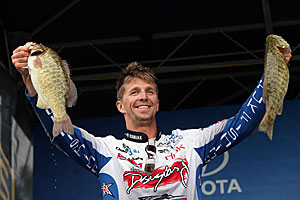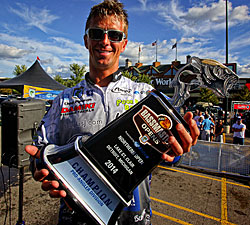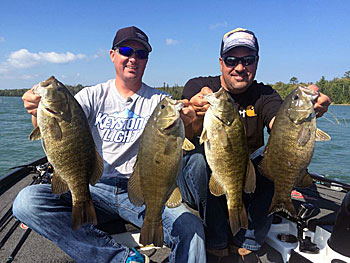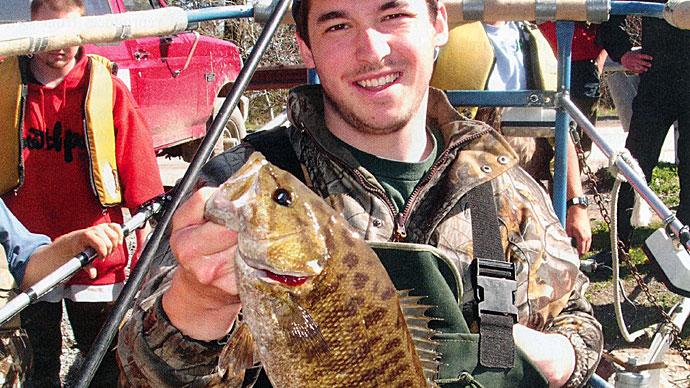
Chad Pipkens is a Bassmaster Elite Series competitor and two-time Bassmaster Classic qualifier. The Michigan angler cut his fishing teeth on his home state’s waters, both big and small. “My biggest strength is catching smallmouth bass,” he said. “I’ve had a lot of fun catching them.” He has won a lot of money with them, too. If the tournament trail takes him to a lake with enough big smallmouth to cash a check, he’ll never look for largemouth bass.
The Bassmaster Elite Series has made an annual northern swing in mid-to-late summer since its inception in 2006. It has stopped at famed waters such as Lake Erie, St. Lawrence River, and Lake Champlain. Mentioning those places turns most anglers’ thoughts straight to giant smallmouth. While no one can predict how many big bronzebacks will be caught in one of those tournaments, everyone knows where competitors will fish and what lures will be used.
Most smallmouth swim in deep water during summer. There, they find a comfortable water temperature and plenty of food, including massive schools of gobies, the bottom-dwelling invasive species that make the smallmouth that eat them huge. They are in the perfect position to be caught on drop shots, tubes, and other deep-water presentations. If these tournaments are your only exposure to smallmouth, you might think it’s the only way to catch them. But that’s not the case. Shallow water produces smallmouth all season long.
Spring
For many years, most northern states prohibited fishing for smallmouth — or largemouth — during the spawn. Bass season didn’t open until early summer, keeping anglers from shallow-water prespawn and spawn bites. The exception was years when winter was particularly wicked. Lingering snow and ice would delay warm water, keeping temperatures in the spawning range when the season finally opened. But in recent years, certain states, such as New York, have instituted spring catch-and-release fishing for bass.
Smallmouth begin cruising shallow flats in early spring. As the water temperature warms, their attention turns to making spawning beds. They lock on anything different on a flat. It might be a log, rock, or anchor for a homeowner’s water intake. Sometimes it’s in no more than 18 inches of water. Weightless worms, such as a Senko rigged Texas or wacky style, will catch many of them once they have locked onto a piece of cover. If the flat has scattered clumps of cover, such as weeds, a small crankbait or spinnerbait fished past each will produce. Smallmouth aren’t rushing to leave these shallow spots once they are done spawning.
Oneida Lake lies just northeast of downtown Syracuse, N.Y. It’s 21 miles long, 5 miles wide, and averages 22 feet deep. Its east-west orientation aligns it with the prevailing winds, so it can fill with giant waves in a hurry, ruining the best fishing plans.
Pipkens fished a Bassmaster Northern Open on Oneida Lake in June 2012. The lake has plenty of largemouth but is better known for its solid smallmouth bass, which were starting to leave their shallow spawning flats during his visit. He found them in 2 to 3 feet of water, where they would smash a heavy spinnerbait and more often explode on a Damiki D Pop topwater lure. When practice was over, he was confident he could catch 18 to 20 pounds daily.
But in true Oneida Lake fashion, the wind kicked up and roiled Pipken’s shallow spots to the point that they were unfishable. He was forced to fish deeper, catching less than he thought but enough to qualify for the Bassmaster Elite Series. “That potential is always there,” Pipkens said of fishing the shallows for smallmouth. “But it’s one of the most vulnerable to the wind.”
Summer
Some smallmouth can be caught shallow in summer, too. Rivers are a great place, especially ones with stained water and moderate current. Smallmouth will often hold tight to the bank, finding refuge from the current in eddies that form immediately downstream from a small rock point or logjam. Boat control is vital to successful presentations, so fish upstream whenever possible. Cast small chartreuse spinnerbaits sporting a mix of Indiana and Colorado blades or small firetiger crankbaits into the eddies and along the seams, where fast and slow water meet. Topwaters, especially buzzbaits, can bring fast action.

You must be punctual when fishing for shallow summer smallmouth swimming in lakes because the bite doesn’t last all day. Fishing is best during the early morning and late evening, and you should focus on shallow flats near deep water. The tops of shoals or reefs are excellent places, especially where you find a well-defined edge that gives smallmouth a route to move and feed. It could be formed by aquatic vegetation, a drop-off, or even a giant boulder. It might be where a vein of rock butts against sand or muck.
One of the best lures for summer smallmouth in lakes is a heavy spinnerbait with double willow blades, sizes 4 and 4.5. A soft-plastic trailer is unnecessary, but don’t throw one without a trailer hook. It will catch smallmouth that slap at your spinnerbait. Choose one that weighs at least ½ ounce, though a ¾- or 1-ounce model will cast farther and run more accurately at faster speeds. Despite the slight resurgence this time-tested lure made following Jason Christie’s run at the 2016 Bassmaster Classic on Oklahoma’s Grand Lake o’ the Cherokees, its popularity hasn’t returned to its former glory. You’re missing out if you don’t throw one. Lipless crankbaits and walking topwaters will catch their share, too.
You’ll need to fish it fast regardless of what you tie on. Speed is a crucial attractor for smallmouth. And just because you are fishing fast doesn’t mean you have to avoid soft plastics. A tube slipped over an 1/8-ounce jighead can be retrieved with constant twitches that cause it to swim off the bottom. Alternating a half-dozen quick twitches with a long pause will cause a soft jerkbait to attract and then surrender to aggressive smallmouth.
Speedy retrieves draw vicious strikes when it feels like the rod will leave your hand. But some days, smallmouth will only follow your lure regardless of its speed. They might swim directly behind or cruise slightly below it. Keep your eyes open for them. If you see one, pick up a tube or small jig and drag it across the bottom. Often that will entice a follower to strike.
Fall
Pipkens said smallmouth go shallow in the fall for several reasons. “It’s certainly the conditions and time of year,” he said. “But it’s the bait.” Those baitfish, often small yellow perch, move shallow as water temperatures fall, and the smallmouth stay on their tails. When you find them, you’ll be within sight of the bank. But the actual depth depends on the body of water.
In early September 2014, the Bassmaster Northern Opens headed to Lake St. Clair near Detroit for the season’s final event. Pipkens was there and chose to run down the Detroit River to Lake Erie, fighting big waves each of the three days. While most of his fellow competitors who made the run fished water 15 to 25 feet deep, Pipkens went shallow — for Erie. He generated strikes by bouncing a Damiki DC300 crankbait off patches of rocks scattered across shoals in 8 to 12 feet of water. He weighed 15 smallmouth for 67 pounds and 4 ounces, which was enough to win.

Pipkens said smallmouth are a different breed of fish. You might see them cruising a shallow sand flat less than 3 feet deep on a sunny fall day. “I like sunny,” he said. “A little breeze to break up the surface helps, too.” You can sometimes sight fish for them, he said, though soft jerkbaits, crankbaits, topwaters, and hard jerkbaits are usually the lures he ties on.
Shallow smallmouth form small schools in the fall, Pipkens said, and their movements across flats aren’t random. Like in the spring, they relate to a piece of cover or structure, no matter how small it is. He catches big smallmouth and numbers of them from those spots. The secret is to keep moving until you locate a school. “You might go a couple of hours without a bite,” he said. “Then you’ll get seven to 10 [smallmouth] in 40 minutes.” The key to getting the most bites is boat position. He said you can plan ahead, positioning your boat within casting range if you know where those little structures and cover changes are. That will keep you from spooking the smallmouth.
Chad Grigsby knows a thing or two about smallmouth, too. He also grew up in Michigan but now calls Maple Grove, Minn., home. He spent 14 years competing on the FLW Tour, recording one win and qualifying for the Forest Wood Cup four times. He’s fishing the Bassmaster Elite Series for the first time in 2016.
“There are always some smallmouth shallow,” Grigsby said. “You catch them there in the spring, but it’s full-on in the fall. Many big ones go up shallow when the water temperature [falls to] 64 degrees, about where it is during the spawn.” He said that temperature tricks smallmouth into trying to spawn again. They go as far as fanning out nests and then defending them. It’s a pattern that he and his longtime friend Mark Zona used to film a recent episode of Mark Zona’s Awesome Fishing Show.
Grigsby’s not sure why smallmouth try to spawn again, but he said it’s an annual event. “This happens in the vast majority of fisheries across the smallmouth’s range,” he said. “It’ll be a pretty good pattern for a couple of weeks.” They bite better than during the actual spawn. That’s because they are feeding up for winter, he said.
Like Pipkens, Grigsby searches out specific spots on vast flats for autumn “spawners.” He looks for dark spots. “The dark spots can be a little rock pile,” Grigsby said, or any other piece of debris. Shallow banks of reeds or other emergent aquatic grass can also hold fall smallmouth.
Grigsby stays as far back as possible and still reaches his targets with his lure. Spinning rods 7 feet or longer coupled with reels spooled with small-diameter braided line can help you gain the casting distance you need. He mostly leans on jigs and tubes, but wacky rigged worms and even drop shots will catch them, too.



